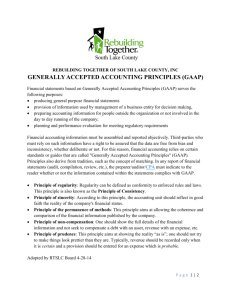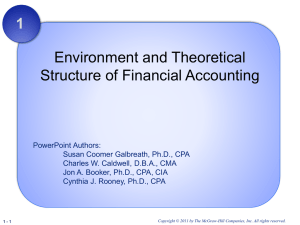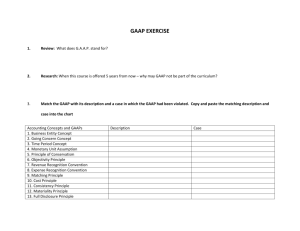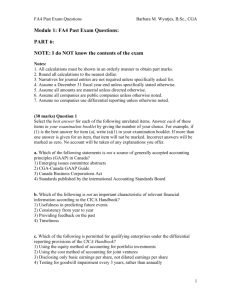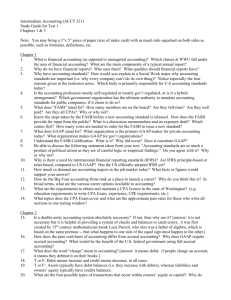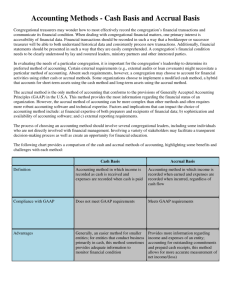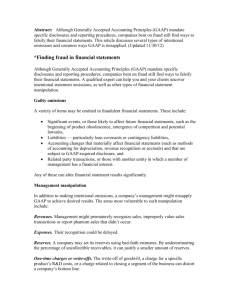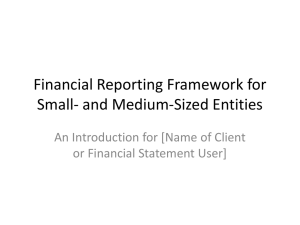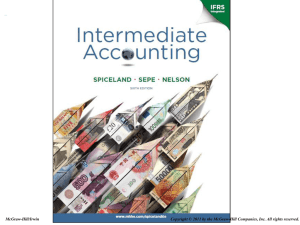This Ain`t Your Momma`s Quickbooks!
advertisement
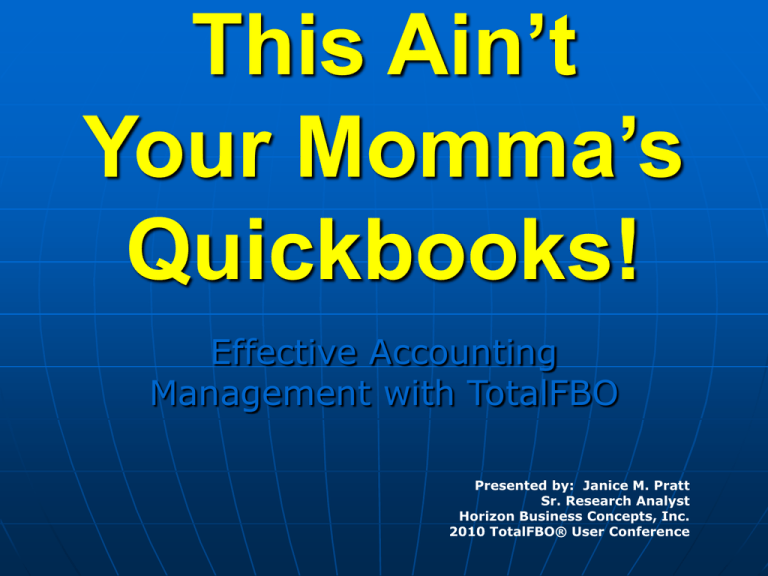
This Ain’t Your Momma’s Quickbooks! Effective Accounting Management with TotalFBO Presented by: Janice M. Pratt Sr. Research Analyst Horizon Business Concepts, Inc. 2010 TotalFBO® User Conference Do You Do GAAP? Generally Accepted Accounting Principles accounting rules used to prepare, present, and report financial statements includes local applicable Accounting Framework, related accounting law, rules and Accounting Standards The Philosophy of Accounting The conceptual framework for the professional preparation and auditing of financial statements and accounts. The issues which arise include: • the difficulty of establishing a true and fair value of an enterprise and its assets; • the moral basis of disclosure and discretion; • the standards and laws required to satisfy the political needs of investors, employees and other stakeholders. GAAP is Composed of: 4 basic Assumptions 4 basic Principles 4 basic Constraints GAAP Assumptions Business Entity • Separate from personal or other business finances Going Concern • Business is expected to continue Monetary Unit • Stable currency Time-period • Reporting divided into periods GAAP Principles Cost • Verifiable, unbiased asset values Revenue • Income reported when earned, not when cash received (Accrual Accounting) Matching • Expenses reported when related income reported Disclosure • Information disclosed should be enough to make a judgment while keeping costs reasonable GAAP Constraints Objectivity • Financial Statements to be backed up by objective evidence Materiality • Reported information items should be significant Consistency • Use same methods and principles from year to year Prudence • Choose method least likely to overstate assets and income GAAP is Changing Originally promulgated by AICPA Council • American Institute of Certified Public Accountants Now codified and updated by FASB • Financial Accounting Standards Board Soon to be replaced with IFRS • International Financial Reporting Standards also subscribed to by most European countries TotalFBO designed to GAAP Double-entry, accrual system Standard chart of accounts design Control accounts supported by detail ledgers Secure audit trail Work in Process posting Date-sensitive, Date-controlled Business entity database/license structure Spreadsheet Accounting (Quickbooks, Excel, Etc.) Can be cash or accrual No balancing required No standard chart of accounts No Work In Process Posting Controls missing or easily overriden Designed to be uploaded to “professional” system for CPA review Assumes purpose is mainly for tax preparation task Professional Accounting Use Professional Accounting System to achieve professional results • TotalFBO, MAS90, Great Plains Use Spreadsheet Accounting System when accountability and growth are not considerations • Clubs, personal finances, analysis Who will do your accounting? Accounting clerk Bookkeeper Full-charge Bookkeeper Accountant CPA CFO Your spouse Accountant Training Daily business information & statement preparation Pricing decisions & business modeling Tax preparation Auditing Specialty areas (international, oil & gas, securities) Financial planning Should you hire a CPA? YES! For specialty areas (planning & income tax prep) For audits For business changes (acquisitions, sales, legal entity choices) For certain Analysis projects NO! For daily bookkeeping management For Internal financial statement prep For account reconciliations For sales taxes For payroll “Full-Charge” Bookkeeper Understands double-entry accrual system Can prepare financial statements with integrity Fully skilled in sub-ledger management Can manage accounting staff Can see the “big picture” Can customize POS, chart of accounts, and other systems to produce appropriate information Elements of Accounting System General Journal General Ledger Detail Ledgers: • • • • • • Accounts Receivable Accounts Payable Bank Accounts Payroll Ledger Inventory Changes Asset Management Supporting Documentation Financial Reports Journals Account Details Trial Balance Bank Account Reconciliations Accounts Payable Aging Accounts Receivable Aging Physical Inventory Valuation Payroll Register Asset Valuation Budget Comparisons Financial Statements Balance Sheet What is the value of the business at any POINT in time? Includes Assets, Liabilities, Net Worth Income Statement (Profit & Loss) What is the income relative to costs, expenses and taxes for a specified PERIOD of time? Cash Flows What were the sources of cash into the company and how/where was it spent? Those Debit & Credit Thingeys... The heart of “Double Entry” accounting LEFT and RIGHT sides… OF WHAT? What’s the point? Isn’t it just double work? Assures Math accuracy Shows Effect on business and Source of the change Balancing the Books Dr ASSETS LIABILITIES Cash Receivables Inventory Building & Equipment “Goodwill” Payables Loans Cr EQUITY Investment Net Profit or Loss: Dr INCOME Sales Interest Asset Sales EXPENSES Cr Costs Expenses Payroll Taxes Evaluating Performance Are financial statements timely? Are they complete? Are they accurate? Does department seem “always behind”? Is one staffer working too hard? Can you get answers to business questions? Is employee flexible as business changes? What’s the Real Problem? Are YOU requiring the wrong things? Is system unnecessarily complex? Have you understaffed? Is equipment/space outdated? Is employee lost/overwhelmed? Is better training the answer? Get Up to Speed Careful hiring and Promotion Practices Bookkeeping Courses www.totalfbo.com/HBCSupport/Educate.aspx Horizon training ??
